MERCEDES-BENZ G-Class 2017 W463 Owner's Manual
Manufacturer: MERCEDES-BENZ, Model Year: 2017, Model line: G-Class, Model: MERCEDES-BENZ G-Class 2017 W463Pages: 286, PDF Size: 4.91 MB
Page 241 of 286
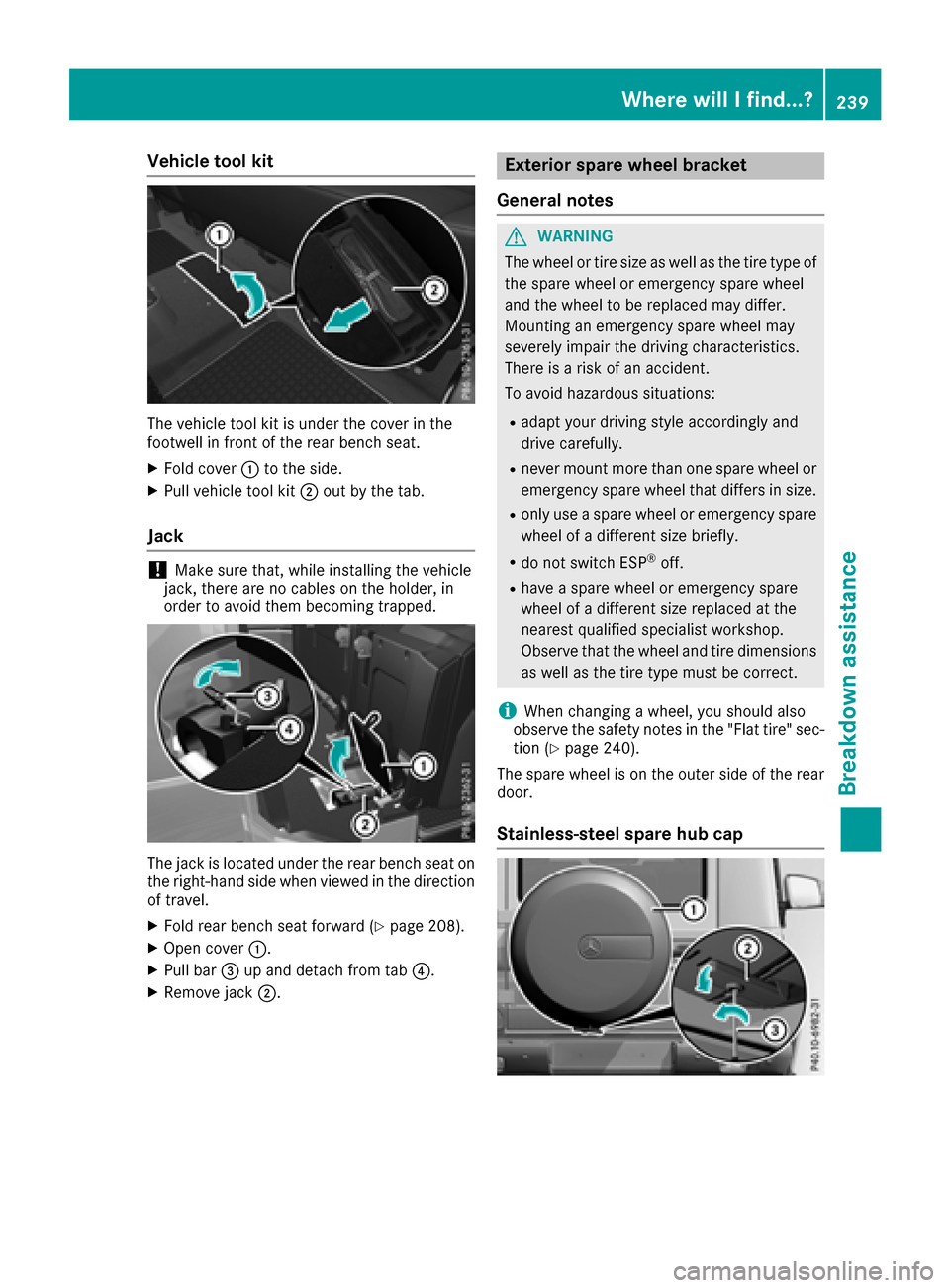
Vehicletoolkit
The vehicl etool kit is under the coverint he
footwell in front of the rearb ench seat.
XFoldc over:to the side.
XPull vehicl etool kit ;outb ythe tab.
Jack
!Make sure that, whil einstalling the vehicle
jack, ther eare no cable sonthe holder, in
order to avoid them becoming trapped.
The jack is locate dunder the rearb ench sea ton
the right-hand side when viewe dinthe direction
of travel.
XFoldr earb ench sea tforward (Ypage 208).
XOpe ncover :.
XPull bar =up and detach from tab ?.
XRemove jack;.
Exterior spare whee lbracket
General notes
GWARNING
The whee lortire size as well as the tire typ eof
the spare whee loremergency spare wheel
and the whee ltobereplaced mayd iffer.
Mounting an emergency spare whee lmay
severely impai rthe driving characteristics.
There is ariskofana ccident.
To avoid hazardouss ituations:
Radap tyou rd riving style accordinglya nd
drive carefully.
Rneve rmount more thano ne spare wheelor
emergency spare whee lthatd iffer sins ize.
Ronlyu seaspare whee loremergency spare
whee lofad ifferent size briefly.
Rdo not switch ESP®off.
Rhave aspare whee loremergency spare
whee lofad ifferent size replaced at the
nearestq ualified specialist workshop.
Observe thatt he wheeland tire dimensions
as well as the tire typ emustbec orrect.
iWhenchanging awheel ,you shoul dalso
observe the safety notes in the "Flat tire "sec-
tio n(
Ypage 240).
The spare whee lisonthe outer side of the rear
door.
Stainless-stee lspare hub cap
Where will Ifind...?239
Breakdo wn assis tance
Z
Page 242 of 286
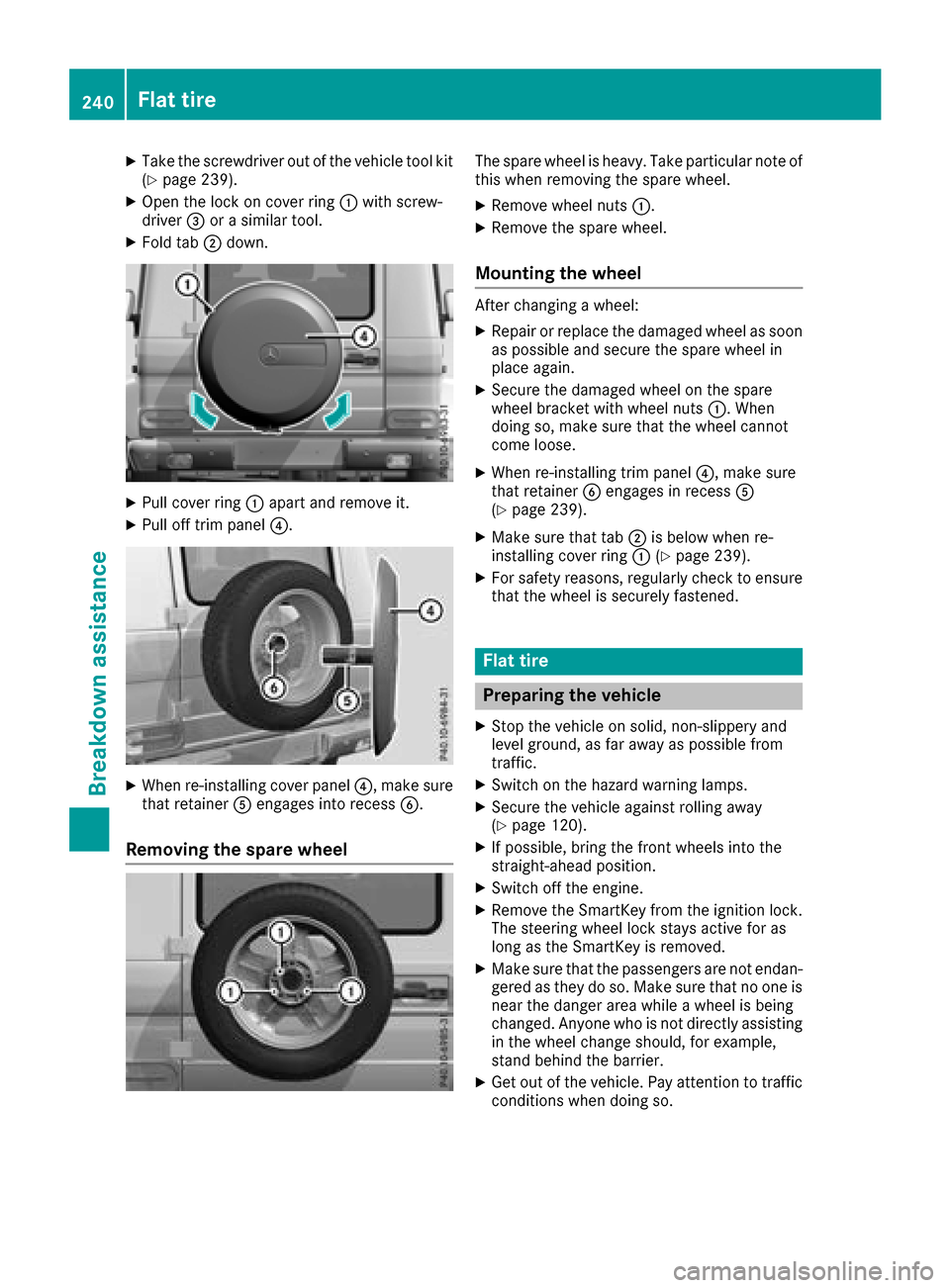
XTake the screwdriver out of the vehicle tool kit(Ypage 239).
XOpen the lock on cover ring :with screw-
driver =oras imilar tool.
XFold tab ;down.
XPull cover ring :apart and remove it.
XPull off trim panel ?.
XWhen re-installing cover panel ?,make sure
that retainer Aengages into recess B.
Removing the sparew heel
The spare wheel is heavy. Take particular noteo f
this when removing the spare wheel.
XRemove wheel nuts :.
XRemove the spare wheel.
Mounting the wheel
After changingawheel:
XRepair or replace the damaged wheel as soon
as possible and secure the spare wheel in
place again.
XSecure the damaged wheel on the spare
wheel bracket with wheel nuts :.When
doing so, make sure that the wheel cannot
come loose.
XWhen re-installing trim panel ?,make sure
that retainer Bengages in recess A
(
Ypage 239).
XMake sure that tab ;is below when re-
installing cover ring :(Ypage 239).
XFor safety reasons, regularly check to ensure
that the wheel is securely fastened.
Flat tire
Preparing the vehicle
XStop the vehicle on solid, non-slippery and
level ground, as far away as possible from
traffic.
XSwitch on the hazard warning lamps.
XSecure the vehicle against rolling away
(Ypage 120).
XIf possible, bring the front wheels into the
straight-ahead position.
XSwitch off the engine.
XRemove the SmartKey from the ignition lock.
The steerin gwheel lock stays active for as
long as the SmartKey is removed.
XMake sure that the passengers are not endan-
gered as they do so. Make sure that no one is
near the danger area while awheel is being
changed. Anyon ewho is not directly assisting
in the wheel change should, for example,
stand behind the barrier.
XGet out of the vehicle. Pay attention to traffic
conditions when doing so.
240Flat tire
Breakdown assistance
Page 243 of 286
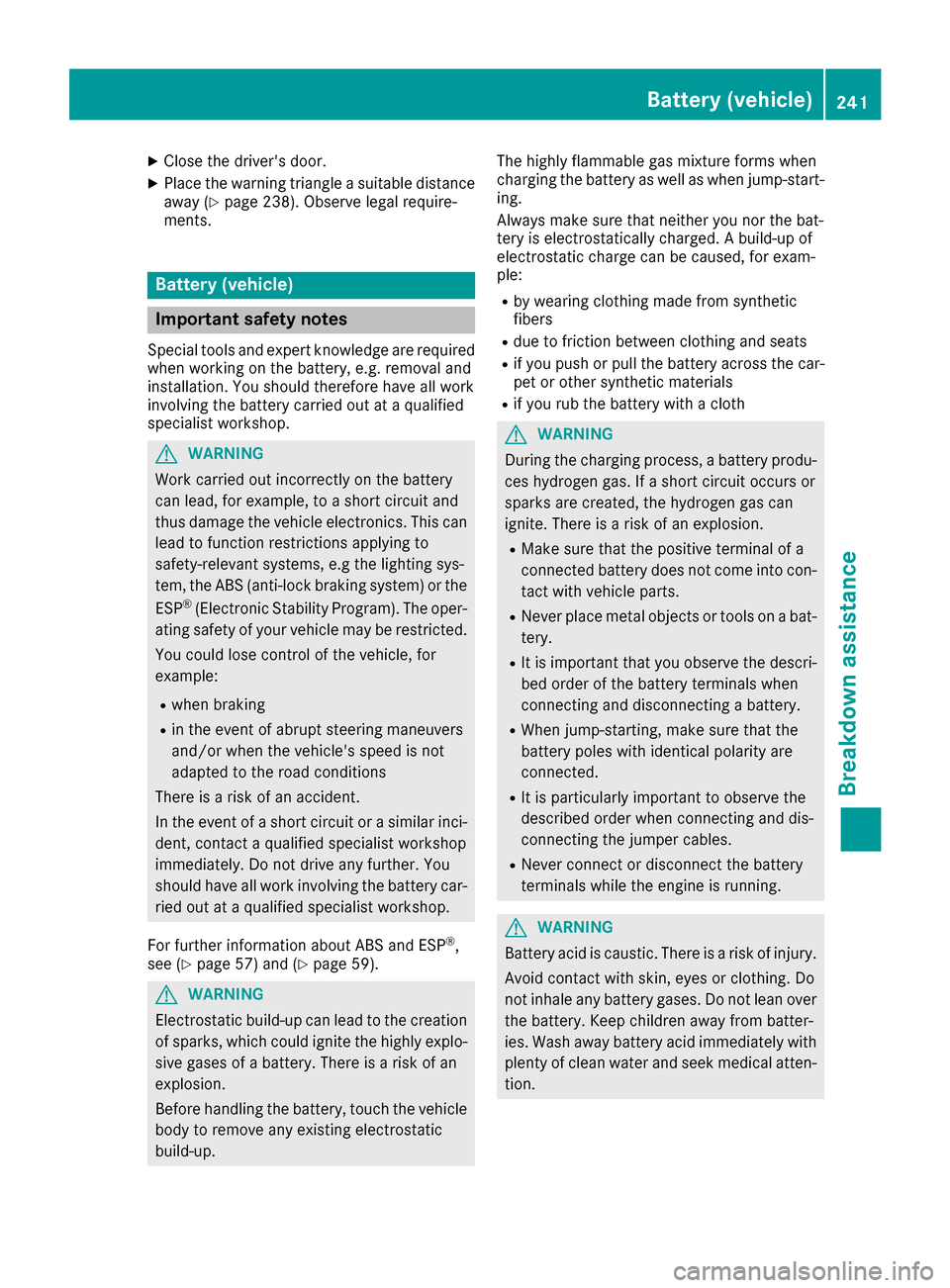
XClose thedriver' sdoor.
XPlacet hewarning triang leas uitable dist ance
away (Ypage 238). Observ elegal require-
ments.
Battery (vehicle)
Important safety notes
Spe cial tools and expertk nowledg eare required
when working on th ebattery, e.g .removal and
installation. You should therefor ehave all work
involving th ebattery carried out at aqualified
specialist workshop.
GWARNING
Workc arried out incorrect lyon th ebattery
can lead, for example ,toashort circuit and
thus damag ethe veh icle electronics .This can
lead to function restrictionsa pplyingto
safety-relevan tsystems ,e.g th elighting sys-
tem, th eABS (anti-lockb raking system) or the
ESP
®(Electron ic Stabilit yProgram). The oper-
atin gsafety of your veh iclemay berestricted.
You could lose control of th evehicle ,for
example:
Rwhen braking
Rin thee vent of abrupt steering maneuvers
and/or when th evehicle 's speedisn ot
adapted to th eroad conditions
Thereisar iskofana cciden t.
In thee vent of ashort circuit or asimilar inci-
dent, contact aqualified specialist workshop
immediately. Do no tdrivea ny further. You
should have all work involving th ebattery car-
ried out at aqualified specialist workshop.
For further informatio nabout AB Sand ESP
®,
see (Ypage 57) and (Ypage 59).
GWAR NING
Electrostat icbuild-up can lead to th ecreation
of sparks ,whichc ouldignite th ehighly explo-
siveg ases of abattery. Thereisar iskofa n
explos ion.
Before handlin gthe battery, touch th evehicle
body to remove any existing electrostatic
build- up. The highly flammable gas mixtur
eforms when
chargin gthe battery as wellas when jump-start-
ing.
Always mak esure that neither you no rthe bat-
tery is electrostatic allycharge d.Ab uild-up of
electrostatic charge can becaused, for exam-
ple:
Rby wearin gclothing made from synthetic
fibe rs
Rdue to friction between clothing and seats
Rif you push or pull th ebattery across th ecar-
pet or other synthetic materials
Rif you rub th ebattery withac loth
GWARNING
During th echargin gprocess, abattery produ-
ces hydrogen gas. If ashort circuit occur sor
sparks are created, th ehydrogen gas can
ignite .Thereisar iskofane xplosion.
RMakes ure that th epositiv etermi nal of a
connected battery does no tcom eintoc on-
tac twithv ehicle parts.
RNever placem etal objectsortoolson abat-
tery.
RIt is important that you observ ethe descri-
bed order of th ebattery terminal swhen
connecting and disconnecting abattery.
RWhen jump-starting, mak esure that the
battery poles withidentical polarity are
connected.
RIt is particularly important to observ ethe
describe dorder when connecting and dis-
connecting th ejumper cables.
RNever connect or disconnect th ebattery
terminal swhile th eengineisr unning.
GWARNING
Battery acid iscaustic .Thereisar iskofi njury.
Avoid contact withskin, eyes or clothing .Do
no tinhale any battery gases.Don otlean over
th eb attery. Keep ch ildren away from batter-
ies. Wash away battery acid immediately with
plenty of clean wate rand seek medical atten-
tion.
Battery (vehicle)241
Breakdown assistance
Z
Page 244 of 286
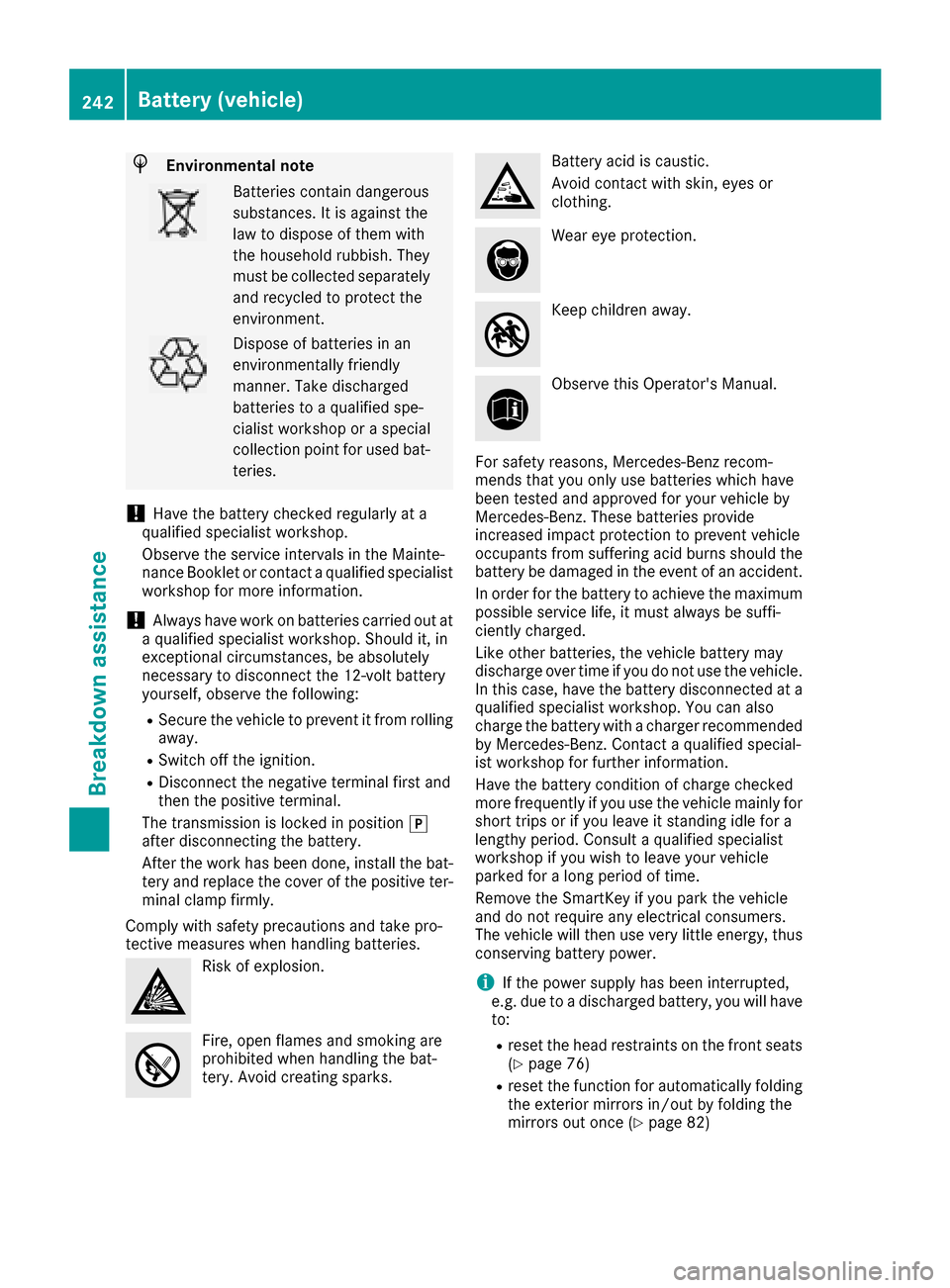
HEnvironmentalnote
Batteries contain dangerous
substances. It is agains tthe
law to dispose of them with
th eh ousehold rubbish. They
must be collected separately and recycled to protect the
environment.
Dispose of batteries in an
environmentally friendly
manner .Take discharged
batteries to aqualifieds pe-
cialis tworkshop or aspecial
collection pointf or used bat-
teries.
!Hav ethe battery checked regularly at a
qualifieds pecialist workshop.
Observe th eservicei ntervals in th eMainte-
nance Bookle torcontac taqualifieds pecialist
workshop for morei nformation.
!Always have work on batteries carried out at
aq ualifieds pecialist workshop.S hould it, in
exceptional circumstances, be absolutely
necessaryt odisconnect th e12-vol tbattery
yourself, observe th efollowing:
RSecure th evehicle to prevent it fro mrolling
away.
RSwitch off th eignition.
RDisconnec tthe negativ eterminal first and
then th epositive terminal.
The transmission is locked in position j
after disconnecting th ebattery.
After th ework has been done, install th ebat-
ter ya nd replacet hecover of th epositive ter-
minal clam pfirmly.
Comply with safet yprecautions and tak epro-
tectiv emeasures when handling batteries.
Risk of explosion.
Fire, open flames and smokin gare
prohibited when handling th ebat-
tery. Avoid creating sparks.
Batter yacid is caustic.
Avoid contac twith skin, eyes or
clothing.
Wear eye protection.
Keep children away.
Observe this Operator's Manual.
For safety reasons ,Mercedes-Ben zrecom-
mends that you onl yuse batteries whichh ave
been tested and approved for your vehicle by
Mercedes-Benz. Theseb atteries provide
increasedi mpactprotection to prevent vehicle
occupant sfroms ufferinga cid burnsshould the
battery be damagedint heeven tofana ccident.
In orderf or thebattery to achieve th emaximum
possible servicel ife, it must always be suffi-
ciently charged.
Likeo ther batteries,t hevehicle battery may
dischargeo ver timeifyou do not use th evehicle.
In this case ,have th ebattery disconnected at a
qualifieds pecialist workshop.Y ou can also
charge th ebattery with acharger recommended
by Mercedes-Benz. Contact aqualifieds pecial-
ist workshop for further information.
Hav ethe battery condition of charge checked
moref requently if you use th evehicle mainly for
shortt rips or if you leave it standin gidle for a
length yperiod. Consult aqualifieds pecialist
workshop if you wish to leave your vehicle
parked for alongp eriodoft ime.
Removet heSmartKey if you park th evehicle
and do not requirea ny electrical consumers.
The vehicle will then use veryl ittle energy, thus
conservingb attery power.
iIf thepower supply has been interrupted,
e.g .due to adischarged battery, you will have
to:
Rreset th ehead restraint sonthefront seats
(Ypage 76)
Rreset th efunction for automatically folding
th ee xteriorm irrorsin/out by folding the
mirrorso ut once(
Ypage 82)
242Battery (vehicle)
Breakdown assistance
Page 245 of 286
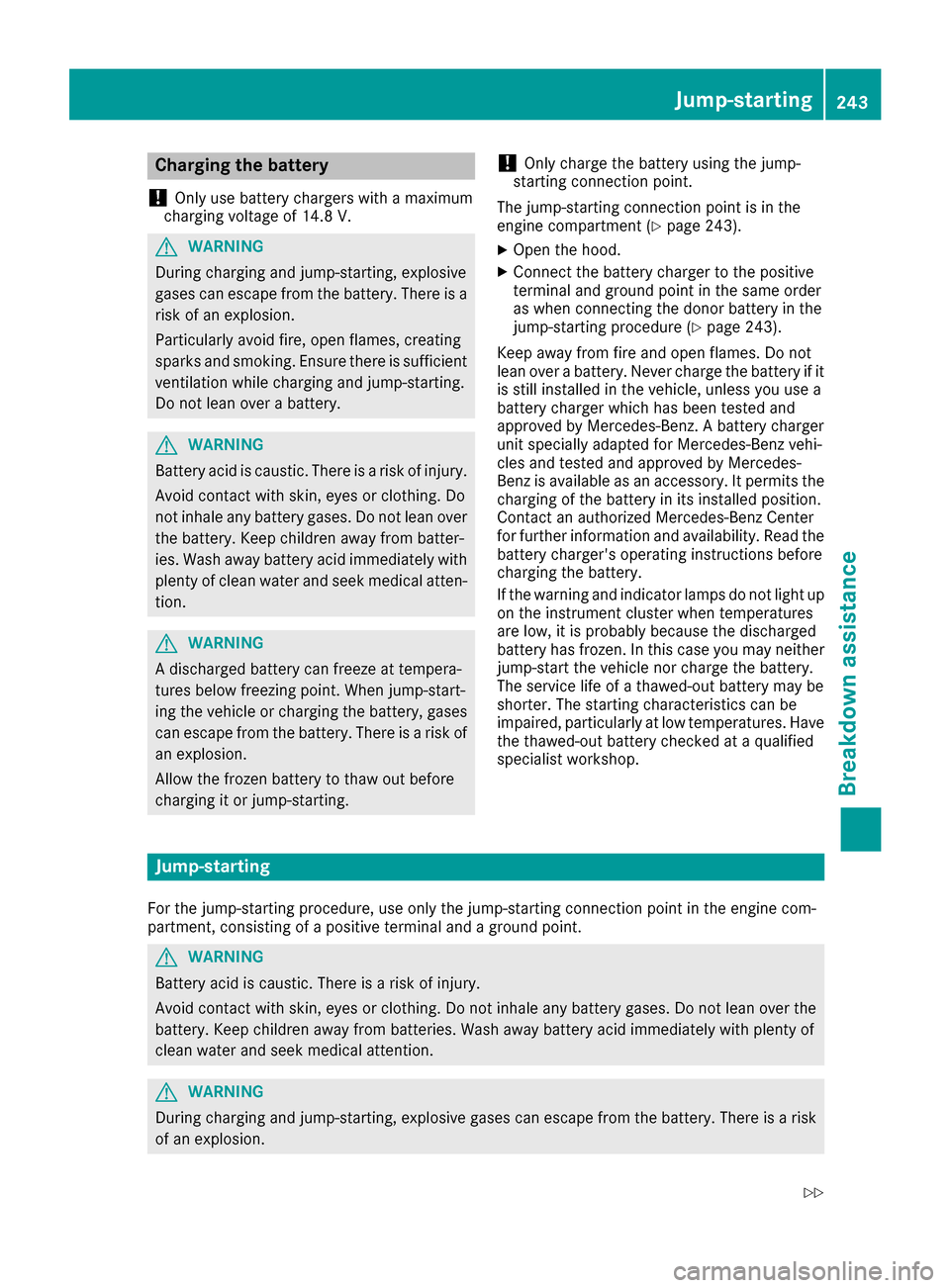
Charging thebattery
!
Only use battery chargers witham aximum
chargin gvoltage of 14.8 V.
GWARNING
During chargin gand jump-starting, explosive
gases can escape from th ebattery. Thereisa
ris kofane xplosion.
Particularly avoid fire, open flames, creating
sparks and smoking. Ensure there is sufficient
ventilatio nwhile chargin gand jump-starting.
Do no tlean ove rabattery.
GWARNING
Battery acid is caustic .Thereisar iskofi njury.
Avoid contac twiths kin, eyes or clothing .Do
no tinhale any battery gases.Don otlean over
th eb attery. Keep childre naway from batter-
ies. Wash away battery acid immediately with
plenty of clean wate rand seek medical atten-
tion.
GWARNING
Ad ischarged battery can freezeatt empera-
tures below freezing point. When jump-start-
ing th evehicle or chargin gthe battery, gases
can escape from th ebattery. Thereisar isko f
an explosion.
Allow th efroze nbattery to thaw out before
chargin gitorjump-starting.
!Only charge th ebattery usingt hejump-
starting connection point.
The jump-startin gconnection pointisint he
enginec ompartmen t(
Ypage 243).
XOpen thehood.
XConnect th ebattery charge rtothepositive
terminal and ground pointint hesame order
as when connecting th edonor battery in the
jump-startin gprocedure (
Ypage 243).
Keep away from fir eand open flames. Do not
lean ove rabattery. Never charge th ebattery if it
is still installed in th evehicle ,unless you use a
battery charge rwhichh as been tested and
approved by Mercedes-Benz. Abattery charger
unit specially adapted for Mercedes-Ben zvehi-
cle sand tested and approved by Mercedes-
Ben zisa vailable as an accessory. It permits the
chargin gofthebattery in its installed position.
Contac tanauthorized Mercedes-Ben zCenter
for further informatio nand availability. Read the
battery charger's operatin ginstructionsb efore
chargin gthe battery.
If th ewarning and indic
ator lamps do no
tlight up
on th einstrumen tcluste rwhen temperatures
are low, it is probably because th edischarged
battery has frozen.Int hisc asey ou may neither
jump-star tthe vehicle no rcharge th ebattery.
The servic elife of athawed-out battery may be
shorter. The starting characteristic scan be
impaired, particularly at low temperatures. Have
th et hawed-out battery checked at aqualified
specialist workshop.
Jump-starting
For th ejump-startin gprocedure, use only th ejump-startin gconnection pointint heenginec om-
partment, consisting of apositiv etermi nal and aground point.
GWARNING
Battery acid is caustic .Thereisar iskofi njury.
Avoid contac twiths kin, eyes or clothing .Donotinhale any battery gases.Don otlean ove rthe
battery. Keep childre naway from batteries .Wash away battery acid immediately withp lenty of
clean wate rand seek medical attention.
GWARNING
During chargin gand jump-starting, explosive gases can escape from th ebattery. Thereisar isk
of an explosion.
Jump-starting243
Breakdown assistance
Z
Page 246 of 286
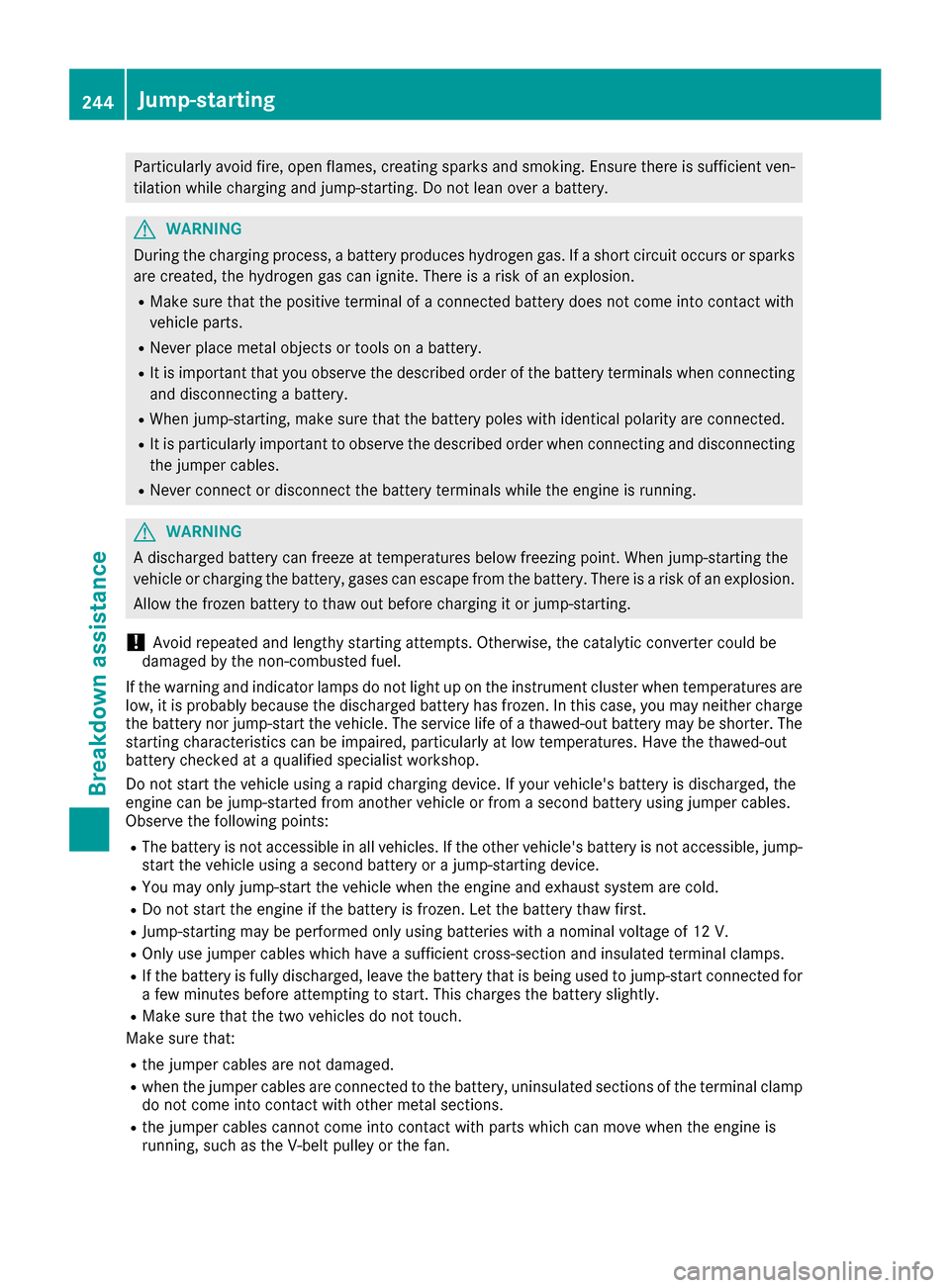
Particularly avoid fire, open flames, creatingsparks and smoking. Ensure there is sufficient ven-
tilation while charging and jump-starting. Do not lean over abattery.
GWARNING
During the charging process, abattery produces hydrogen gas. If ashort circuit occurs or sparks
are created, the hydrogen gas can ignite. There is arisk of an explosion.
RMake sure that the positive terminal of aconnected battery does not come into contact with
vehicle parts.
RNever place metal object sortools on abattery.
RIt is importan tthat you observe the described order of the battery terminals when connecting
and disconnectin gabattery.
RWhen jump-starting, make sure that the battery poles with identical polarity are connected.
RIt is particularly importan ttoobserve the described order when connectin gand disconnecting
the jumper cables.
RNever connect or disconnect the battery terminals while the engine is running.
GWARNING
Ad ischarged battery can freeze at temperatures below freezin gpoint. When jump-starting the
vehicle or charging the battery, gases can escape from the battery. There is arisk of an explosion.
Allow the frozen battery to thaw out before charging it or jump-starting.
!Avoid repeated and lengthy starting attempts. Otherwise, the catalytic converter could be
damaged by the non-combusted fuel.
If the warning and indicator lamps do not light up on the instrument cluster when temperatures are
low, it is probably because the discharged battery has frozen. In this case, you may neither charge
the battery nor jump-start the vehicle. The service life of athawed-out battery may be shorter .The
starting characteristics can be impaired, particularly at low temperatures. Have the thawed-out
battery checked at aqualified specialist workshop.
Do not start the vehicle using arapid charging device. If your vehicle's battery is discharged, the
engine can be jump-started from another vehicle or from asecond battery using jumper cables.
Observe the following points:
RThe battery is not accessible in all vehicles. If the other vehicle's battery is not accessible, jump-
start the vehicle using asecond battery or ajump-starting device.
RYou may only jump-start the vehicle when the engine and exhaust system are cold.
RDo not start the engine if the battery is frozen. Let the battery thaw first.
RJump-starting may be performed only using batteries with anominal voltage of 12 V.
ROnly use jumper cables which have asufficient cross-section and insulated terminal clamps.
RIf the battery is fully discharged, leave the battery that is being used to jump-start connected for
afew minutes before attempting to start .This charges the battery slightly.
RMake sure that the two vehicles do not touch.
Make sure that:
Rthe jumper cables are not damaged.
Rwhen the jumper cables are connected to the battery, uninsulated sections of the terminal clamp
do not come into contact with other metal sections.
Rthe jumper cables cannot come into contact with parts which can move when the engine is
running, such as the V-belt pulley or the fan.
244Jump-starting
Breakdown assistance
Page 247 of 286
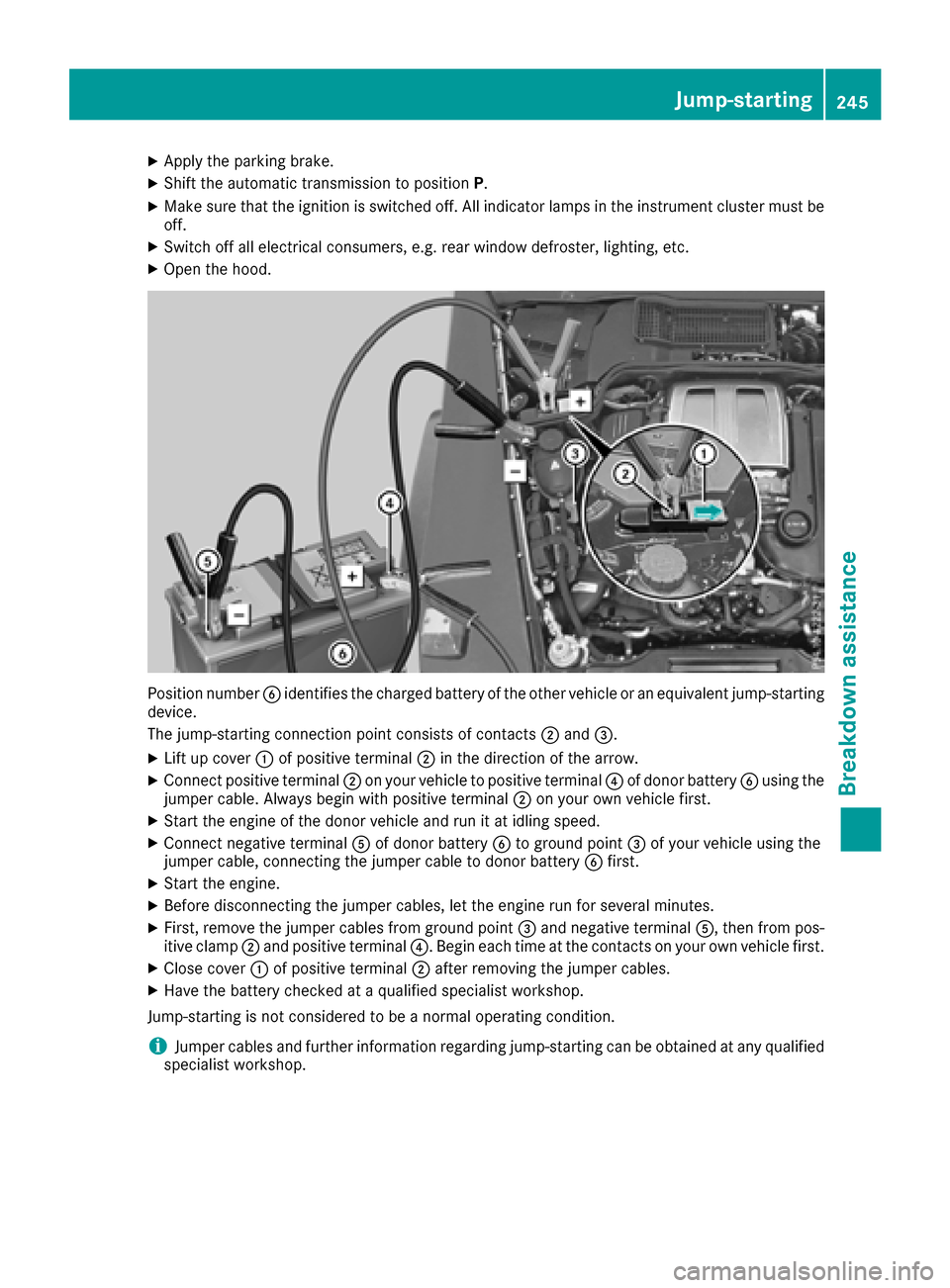
XApply the parking brake.
XShift the automatic transmission to positionP.
XMake sure thatthe ignition is switched off. All indicator lamps in the instrument cluster must be
off.
XSwitch off al lelectrical consumers, e.g .rea rw indo wd efroster, lighting, etc.
XOpe nthe hood.
Position number Bidentifie sthe chargedb attery of the otherv ehicleorane quivalent jump-starting
device.
The jump-starting connectio npoint consists of contacts ;and =.
XLiftu pc over :of positive terminal ;in the direction of the arrow.
XConnect positive terminal ;on your vehicl etopositive terminal ?of donor battery Busing the
jumpe rcable .Alway sbegin with positive terminal ;on your ownv ehiclefirst.
XStar tthe engine of the donor vehicl eand runitati dlingspeed.
XConnect negative terminal Aof donor battery Bto ground point =of your vehicl eusing the
jumpe rcable ,connecting the jumpe rcable to donor battery Bfirst.
XStar tthe engine.
XBefore disconnecting the jumpe rcables, le tthe engine runf or severalminutes.
XFirst, remove the jumpe rcable sfrom ground point =and negative terminal A,then from pos-
itive clamp ;and positive terminal ?.Begin each time at the contacts on your ownv ehiclefirst.
XClose cover :of positive terminal ;afte rremoving the jumpe rcables.
XHav ethe battery checked at aquali fied specialist workshop.
Jump-starting is not considered to be anormalo perating condition.
iJumpe rcable sand furtheri nformationregarding jump-starting can be obtained at any qualified
specialist workshop.
Jump-starting245
Breakdo wn assis tance
Z
Page 248 of 286
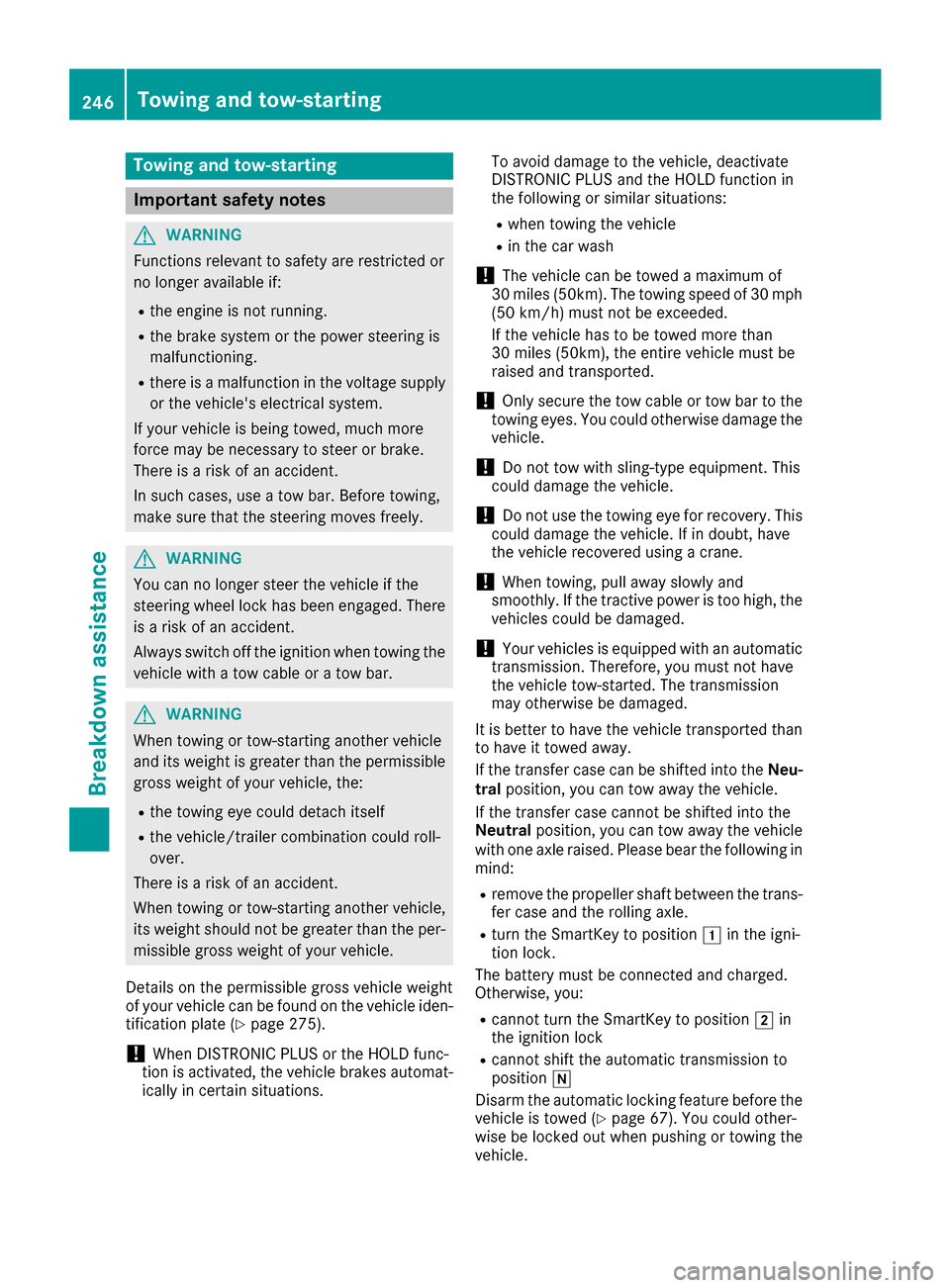
Towingand tow-starting
Important safety notes
GWARNING
Functions relevant to safety ar erestricted or
no longe ravailable if:
Rthe engine is not running.
Rthe brake system or the powe rsteerin gis
malfunctioning.
Rthere is amalfunctio ninthe voltag esuppl y
or the vehicle's electrical system.
If your vehicl eisbeing towed ,muchm ore
force mayben ecessary to stee rorbrake.
There is ariskofana ccident.
In such cases, us eatow bar. Before towing,
make sure thatt he steeringmoves freely.
GWARNING
Yo uc an no longe rstee rthe vehicl eifthe
steerin gwheel lock hasb eene ngaged .There
is ar iskofana ccident.
Alway sswitch off the ignition when towing the
vehicl ewithat ow cable or atow bar.
GWARNING
When towing or tow-startin ganotherv ehicle
and its weight is greate rthant he permissible
gross weight of your vehicle, the:
Rthe towing ey ecould detach itself
Rthe vehicle/trailer combinatio ncould roll-
over.
There is ariskofana ccident.
When towing or tow-startin ganotherv ehicle,
its weight shoul dnot be greate rthant he per-
missibl egross weight of your vehicle.
Detail sonthe permissibl egross vehicl eweigh t
of your vehicl ecan be found on the vehicl eide n-
tification plate (
Ypage 275).
!When DISTRONICP LUSort he HOLD func-
tio nisa ctivated ,the vehicl ebrakes automat-
icall yinc ertain situations. To avoi
ddamag etothe vehicle, deactivate
DISTRONICP LUSa nd the HOLD functio nin
the following or similar situations:
Rwhen towing the vehicle
Rin the car wash
!The vehicl ecan be towed amaximum of
30 miles (50km). The towing spee dof30mph
(50 km/h )mustn ot be exceeded.
If the vehicl ehasto be towed mor ethan
30 miles (50km), the entire vehicl emustb e
raised and transported.
!Onlys ecurethe tow cable or tow ba rtothe
towing eyes. Yo ucould otherwis edamag ethe
vehicle.
!Do not tow with sling-typ eequipment .This
could damage the vehicle.
!Do not us ethe towing ey efor recovery. This
could damage the vehicle. If in doubt, have
the vehicl erecovered using acrane.
!When towing ,pulla wa yslowly and
smoothly. If the tractiv epower is too high, the
vehicles could be damaged.
!Your vehicles is equipped with an automatic
transmission. Therefore ,you must not have
the vehicl etow-started .The transmission
mayo therwis ebedamaged .
It is better to have the vehicl etransporte dthan
to have it towed away.
If the transferc asec an be shifted into the Neu-
tral position, yo ucan tow away the vehicle.
If the transferc asec anno tbes hifted into the
Neutral position, yo ucan tow away the vehicle
with one axl eraised. Please bear the following in
mind:
Rremove the propeller shaft between the trans-
fer cas eand the rolling axle.
Rturnthe SmartKeytop osition 1in the igni-
tio nlock.
The battery must be connected and charged.
Otherwise, you:
Rcanno tturnt he SmartKeytop osition 2in
the ignition lock
Rcanno tshift the automatic transmission to
position i
Disar mthe automatic locking featur ebefor et he
vehicl eistowed (
Ypage 67).Y oucould other-
wise be locked outw henp ushing or towing the
vehicle.
246Towin gand tow-starting
Breakdow nassistance
Page 249 of 286
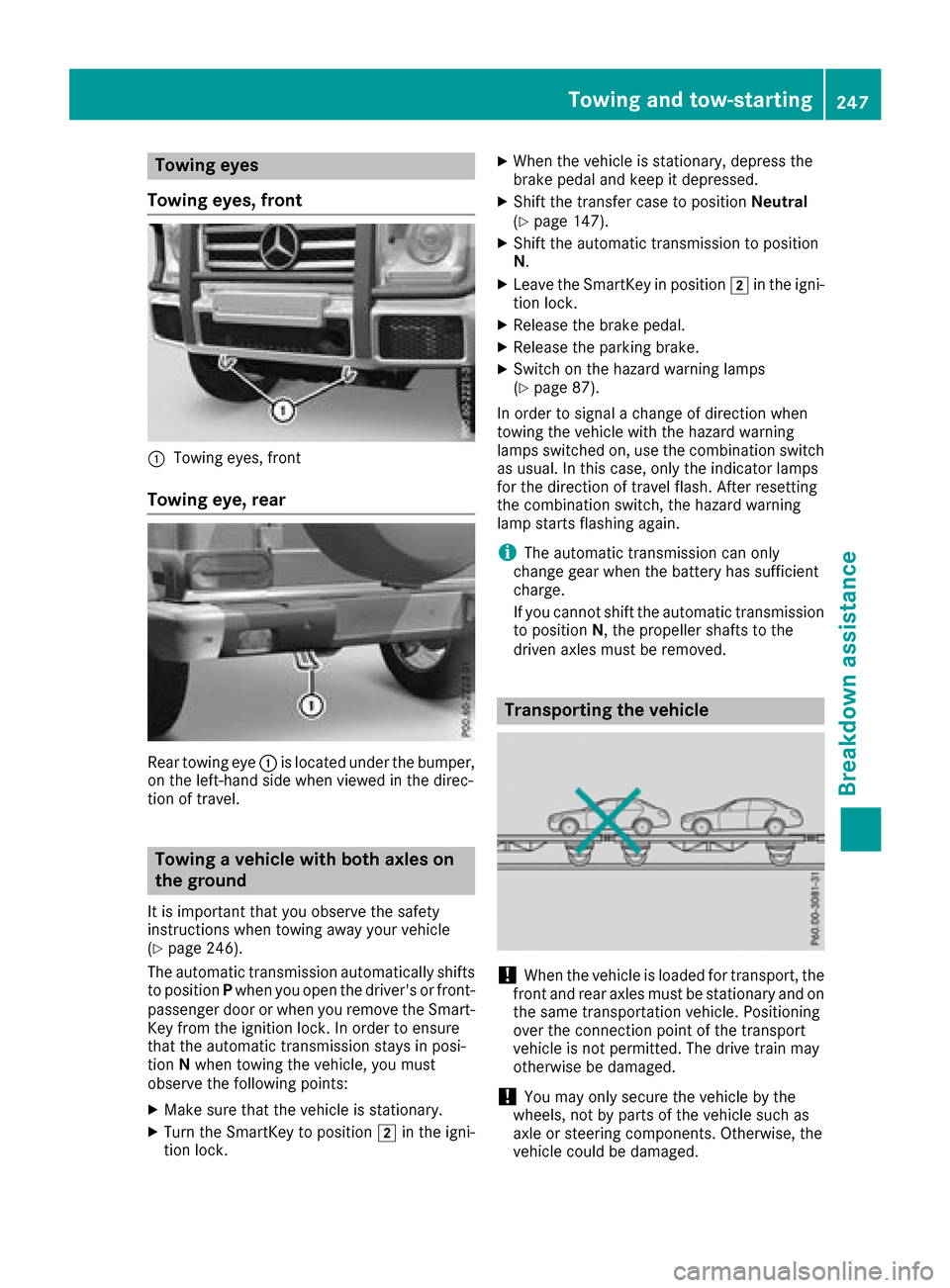
Towingeyes
Towin geyes, front
:Towing eyes, front
Towin geye,rear
Rear towing eye :is locate dunder the bumper,
on the left-hand side when viewe dinthe direc-
tio noft ravel.
Towin gavehicle with both axles on
the ground
It is important thaty ouobserve the safety
instructions when towing away your vehicle
(
Ypage 246).
The automatic transmission automaticall yshifts
to position Pwhen yo uopenthe driver's or front-
passenge rdoororw heny ou remove the Smart-
Key fromt he ignition lock. In order to ensure
thatt he automatic transmission stays in posi-
tion Nwhen towing the vehicle, yo umust
observe the following points:
XMake sure thatt he vehicleisstationary.
XTurn the SmartKeytop osition 2in the igni-
tio nlock.
XWhen the vehicl eisstationary, depress the
brake peda land kee pitdepressed.
XShift the transferc asetop osition Neutral
(Ypage 147).
XShift the automatic transmission to position
N.
XLeave the SmartKeyinp osition2in the igni-
tio nlock.
XReleas ethe brake pedal.
XReleas ethe parkin gbrake.
XSwitch on the hazar dwarning lamps
(Ypage 87).
In order to signa lachange of direction when
towing the vehicl ewitht he hazar dwarning
lamps switched on, us ethe combinatio nswitch
as usual. In thisc ase, onlythe indicator lamps
for the direction of travel flash. After res etting
th
e combinatio nswitch ,the hazar dwarning
lamp starts flashing again.
iThe automatic transmission can only
change gear when the battery hass ufficient
charge.
If yo ucanno tshift the automatic transmission
to position N,the propeller shafts to the
driven axles must be removed.
Transporting the vehicle
!When the vehicl eisloade dfor transport, the
front and rea raxles must be stationar yand on
the same transportatio nvehicle. Positioning
ove rthe connectio npoint of the transport
vehicl eisnot permitted .The drive train may
otherwis ebedamaged .
!Youm ayonl ysecur ethe vehicl ebythe
wheels ,not by parts of the vehicl esucha s
axl eors teerin gcomponents. Otherwise, the
vehicl ecould be damaged.
Towin gand tow-starting247
Breakdow nassistance
Z
Page 250 of 286
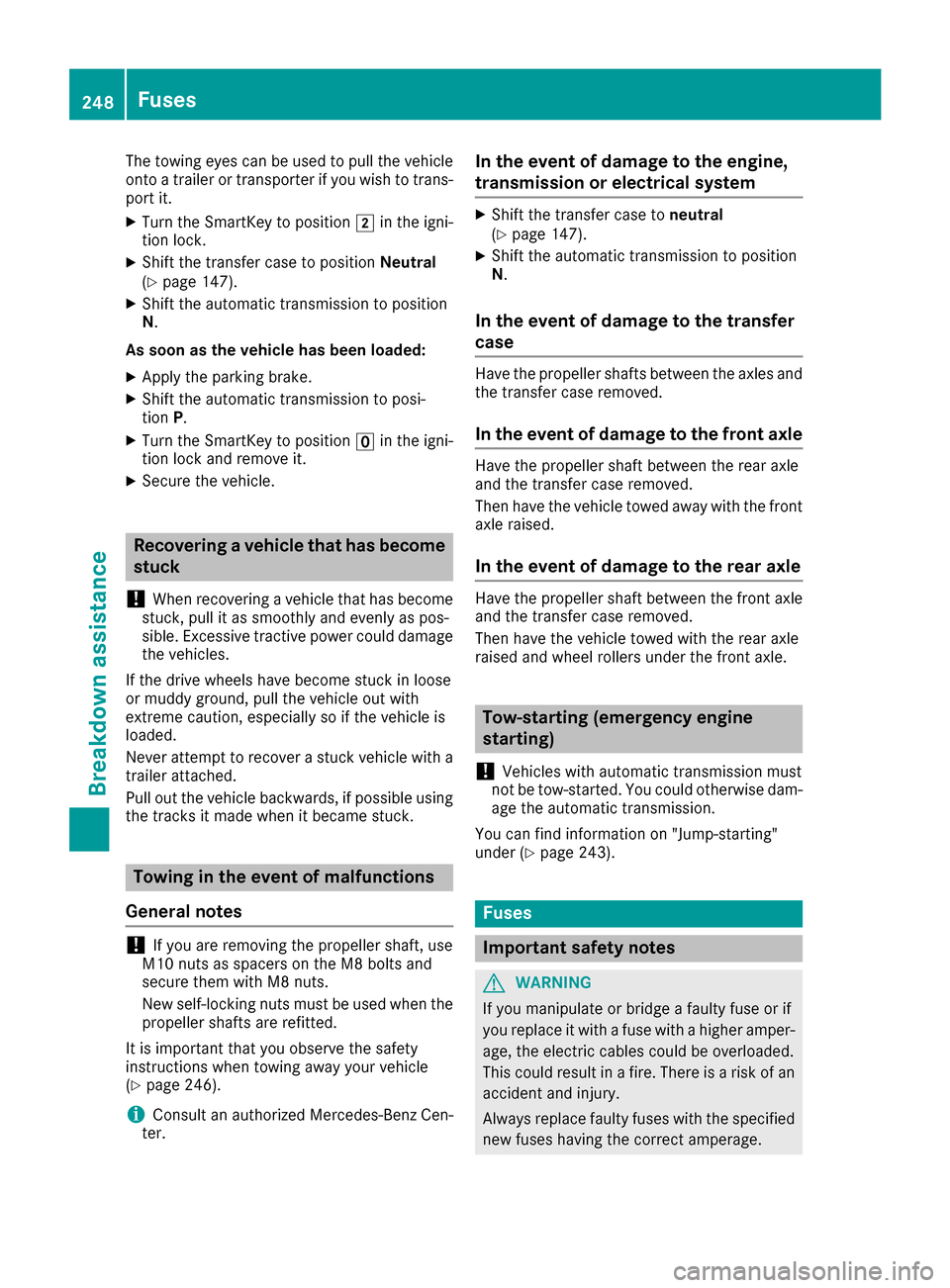
The towing eyes can be used to pull the vehicle
ontoatrailer or transporter if you wish to trans-
port it.
XTurn the SmartKey to position 2in the igni-
tion lock.
XShift the transfer case to position Neutral
(Ypage 147).
XShift the automatic transmission to position
N .
As soon as the vehicle has been loaded:
XApply the parking brake.
XShift the automatic transmission to posi-
tion P.
XTurn the SmartKey to position uin the igni-
tion lock and remove it.
XSecure the vehicle.
Recovering avehicle thath as become
stuck
!
When recovering avehicle that has become
stuck ,pull it as smoothly and evenly as pos-
sible. Excessive tractive power could damage
the vehicles.
If the drive wheels have become stuck in loose
or muddy ground, pull the vehicle out with
extreme caution, especially so if the vehicle is
loaded.
Never attempt to recover astuck vehicle with a
trailer attached.
Pull out the vehicle backwards, if possible using the track sitmade when it became stuck.
Towing in the event of malfunctions
General notes
!If you are removing the propeller shaft, use
M10 nuts as spacers on the M8 bolts and
secure them with M8 nuts.
New self-locking nuts must be used when the
propeller shafts are refitted.
It is important that you observe the safety
instructions when towing away your vehicle
(
Ypage 246).
iConsult an authorized Mercedes-Benz Cen-
ter.
In the event of damage to the engine,
transmission or electrical system
XShift the transfer case to neutral
(Ypage 147).
XShift the automatic transmission to position
N .
In the event of damage to the transfer
case
Have the propeller shafts between the axles and
the transfer case removed.
In the event of damage to the front axle
Have the propeller shaft between the rear axle
and the transfer case removed.
Then have the vehicle towed away with the front
axle raised.
In the event of damage to the rear axle
Have the propeller shaft between the front axle
and the transfer case removed.
Then have the vehicle towed with the rear axle
raised and wheel rollers under the front axle.
Tow-starting (emergency engine
starting)
!
Vehicles with automatic transmission must
not be tow-started. You could otherwise dam-
age the automatic transmission.
You can find information on "Jump-starting"
under (
Ypage 243).
Fuses
Important safety notes
GWARNING
If you manipulate or bridge afaulty fuse or if
you replace it with afuse with ahigher amper-
age, the electric cables could be overloaded.
This could result in afire. There is arisk of an
accident and injury.
Always replace faulty fuses with the specified
new fuses having the correcta mperage.
248Fuses
Breakdown assistance